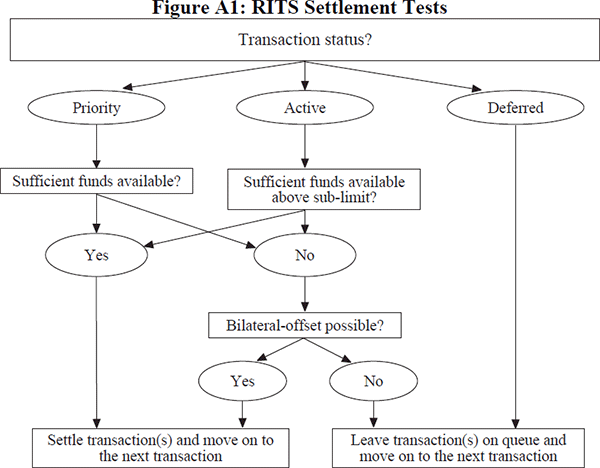RDP 2012-05: Payment System Design and Participant Operational Disruptions Appendix A: Simulator Algorithms
September 2012 – ISSN 1320-7229 (Print), ISSN 1448-5109 (Online)
- Download the Paper 578KB
The algorithms in the Bank of Finland simulator were modified to broadly replicate the hybrid features in RITS. In particular, we modified the bilateral-offset algorithm to test all queued transactions. Our algorithm tests each queued transaction against a maximum of ten offsetting transactions, starting with the first queued offsetting transaction and adding, in FIFO order, up to nine further offsetting transactions. Applying this algorithm, 27 per cent of the total value of settlements is settled via bilateral offset, which is close to the actual share of payments (25 per cent) settled via bilateral offset in RITS. This compares with around 5 to 10 per cent using the unmodified algorithm (which only tests for simultaneous settlement of transactions between the counterparties of the first queued transaction). The remaining difference between the bilateral-offset algorithm constructed for the purposes of the simulation and the RITS functionality is that for the former, payments are only tested for bilateral offset once all payments have been tested for individual settlement. In contrast, RITS first tests each payment for individual settlement and then checks whether a bilateral offset is possible (as long as the payment has been queued for at least a minute), before moving on to the next payment (Figure A1).

In the simulator, the entry, queue and bilateral-offset algorithms have been modified to broadly match RITS' sub-limit functionality. Based on a payment's status these algorithms adjust the amount of liquidity available to settle that payment based on the sub-limit data, which is entered using the bilateral limits input table. Given the inability to allow for changes to payment status in the simulations, as well as a lack of data on precisely what time these changes occurred, the rules of thumb used to determine a payment's status and the submission time are as shown in Table A1. These are based on when the status was most likely to have changed.[18]
| Status when submitted to RITS | Status when settled in RITS | Status when submitted to the simulator | Time when submitted to the simulator |
|---|---|---|---|
| Deferred | Active | Active | Settlement time in RITS |
| Priority | Priority | Settlement time in RITS | |
| Active | Active | Active | Submission time to RITS |
| Priority | Priority | Settlement time in RITS | |
| Priority | Active | Priority | Submission time to RITS |
| Priority | Priority | Submission time to RITS | |
| Note: In the pure RTGS system, all payments are submitted to the simulator at the time they were settled in RITS and payment status is irrelevant. | |||